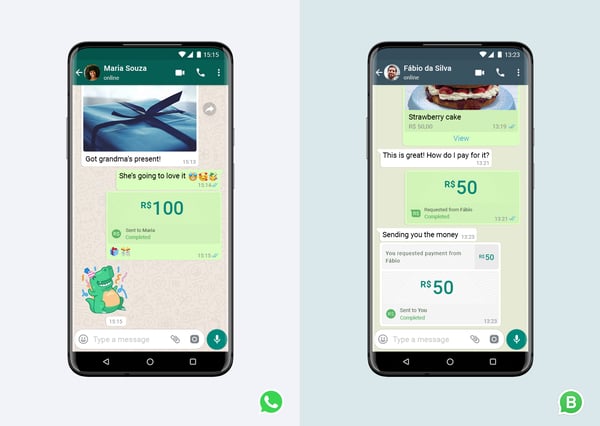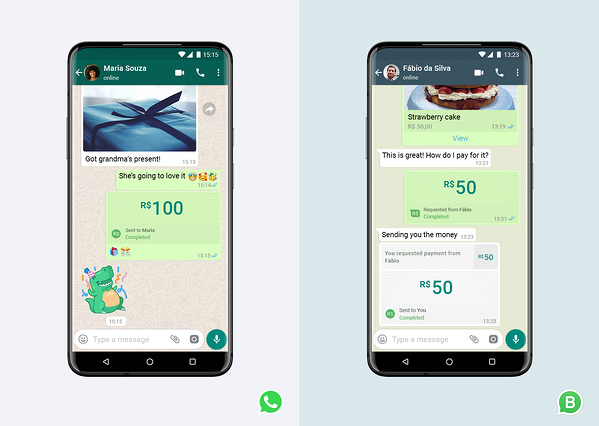Since launching over a decade ago, WhatsApp has gained popularity all over the world.
As the chat app’sglobal user-base has continued to expand, so has its platform. After adding features like group chat and video capabilities, the platform quickly became a place where brands can directly interact with consumers.
In 2019, due to WhatsApp’s booming popularity, it launched one of its biggest features yet:a specialized app called WhatsApp Business. This app, which passed five million active users in its first year, is quite similar to the consumer version of WhatsApp. However, it allows companies to create a public business profile that includes links to ecommerce stores and a catalog of product shots.
But WhatsApp didn’t stop at Business pages. In 2020, the company began rolling out an online payment feature. The feature has already launched on the Brazil-based app but will ultimately expand globally.
According to the brand, the WhatsApp payments tool will allow payments to be accepted by brands with WhatsApp Business pages for a 3.99% processing fee.
One of the major reasons WhatsApp’s payment feature, powered by Facebook Pay’s transaction software, is being launched in Brazil first is so WhatsApp can learn more about how local benefits can benefit from chat transactions. Prior to this launch, WhatsApp was already one of the top messaging platforms in Brazil and had already seen a number of brands use it to engage with audiences in this region.
“Over 10 million small and micro-businesses are the heartbeat of Brazil’s communities. It’s become second nature to send a zap to a business to get questions answered. Now in addition to viewing a store’s catalog, customers will be able to send payments for products as well. Making payments simple can help bring more businesses into the digital economy, opening up new opportunities for growth,” a blog post from WhatsApp explains.
Below, I’ll walk through how the payments feature works and how brands can leverage it within their WhatsApp or mobile messaging strategies.
How WhatsApp’s Payment Feature Works
Because the payment feature is powered by Facebook Pay’s software, sending a payment on WhatsApp will be quite similar to sending one via Facebook.
To give you a better idea of how the tool will work when it appears on global WhatsApp platforms, I’ll start by walking you through what the consumer sees.
Like Facebook Pay, WhatsApp users will have to enter their MasterCard or Visa information in the settings area of their profile. Users do not need Facebook to use the WhatsApp feature, however, the two companies are working on an integration that will enable users also on Facebook Pay to submit one payment method for both platforms, rather than having to enter the same information twice.
Aside from adding a credit or debit card, users will also need to include information for the bank account which will receive their payments. Currently, to receive or send money, users need an account at one of WhatsApp’s three Brazilian bank partners. However, as the feature expands to different countries, WhatsApp will be partnering with banks in each new area.
Once payment information has been added, users can open a chat thread with a friend, go to the message field, and tap a pay button. From there, they can type in the amount they’d like to send, and send it to their contact with no added transaction fees.

Image Source
Before the transaction is finalized, WhatsApp will ask senders to confirm their identity with a six-digit pin or fingerprint.
Although WhatsApp has not gone into great detail about how this feature will look for brands, its announcement suggests that shoppers can start a chat with a business — as they would with a friend, discuss a product or service, and then securely make a purchase directly in the chat.
Now that you know a bit about how WhatsApp payments will work, here are a few benefits that this feature could offer your business.
How Brands Can Benefit From WhatsApp Payments
1. Chatting with customers could result in immediate purchases.
Each day, conversational marketers and community managers answer a handful of questions asked in social media posts, comment threads, and direct messages. Meanwhile, sales reps might communicate with prospects via email, Slack, WhatsApp, or another form of direct messaging.
While modern technology has provided a number of ways to communicate with prospects, there can still be a major friction point when the chat ends. After that point, the rep or marketer needs the prospect to venture to an ecommerce site or landing page, fill in their personal information, and buy the product or service. When prospects spend a lot of time chatting with company reps, but ultimately don’t buy the product, the time devoted to messaging them can feel like a major waste.
WhatsApp’s payment tool removes some of the friction that comes between a chat and a purchase. Rather than sending a prospect links to your WhatsApp Business catalog or ecommerce site and hoping they click, research the product, add it to their cart, and buy it, you can give them all the information they might need, answer any of their questions, and then offer them the opportunity to purchase a product or service directly in the chat.
2. The WhatsApp payment tool offers local businesses new or additional revenue streams.
As WhatsApp noted in its announcement, consumers in Brazil were already contacting brands, asking them questions, getting product recommendations, and even sending their payment details in chats before WhatsApp added the option to make a full transaction. WhatsApp has also become a common way for people in Brazil to learn about and interact with local businesses or shops that might not have full ecommerce sites.
For small and local businesses dabbling in online sales, WhatsApp offers a new revenue stream opportunity that doesn’t require them to build a robust online catalog or website. They can now promote their business and current products, chat with prospects, and sell products all from one platform.
For example, if you own or work as a marketer for a small or local business, especially in a region that heavily uses WhatsApp, creating a Business account could allow you to promote your brand with a business page and online product catalog. From there, when a user is interested in one of your catalog items, you can begin to experiment with processing online purchases for the first time.
If you already have an ecommerce site, you can use a WhatsApp Business account to promote your online store while also using your catalog and chat features to highlight or sell specific items, such as products that are new to the store
3. Marketers and brands can better track customer journeys and ROI.
Now that customers can learn about a brand, chat with them, and make a purchase directly on WhatsApp, brands can use past threads to learn more about which chats lead to purchases, which don’t, and how much ROI they’re getting from WhatsApp payments — even with the service fee.
As brands tiptoe further into digital transformation, learning about how to reel in and convert customers will be important. Because the entire buyer’s journey can now happen on WhatsApp, brands can better get an idea of why consumers convert and what might be knocking them off of a conversion path.
Similarly, if a brand tests out a marketing campaign on WhatsApp, that company isn’t limited to sending online store tracking URLs to determine how successful their marketing content was. If a user who interacts with the WhatsApp campaign also makes a purchase through a private chat, this could also be tracked as ROI.
On WhatsApp, marketers and sales reps might use chats to get to know the user, inform them of great purchases they could make, and ultimately build the trust needed to convert the person to a customer.
Although a brand could simply end a chat after a customer makes a payment, they could alternatively check back in with a customer to let them know their package was shipped, check-in to see how the product is working, and inform them of new deals or products they might be interested in later. This method could, in turn, result in upselling, more purchases, and more brand trust.
If you intend to leverage WhatsApp’s payment tool once it’s fully launched, keep in mind that there are major benefits to continuing customer relationships rather than just abandoning the chat after you get their money.
Bringing the Buyer’s Journey to WhatsApp Chat
Now that WhatsApp allows users to better discover, learn about, interact with, and pay brands through WhatsApp Business, the platform has brought the buyer’s journey fully mobile.
As a marketer or sales rep, it will be your job to help the prospect with their questions and guide them through the buyer’s journey. With the WhatsApp payment feature, you can more smoothly move them from a lead to a customer. Then, you can continue to use the chat and other WhatsApp features to build your brand to customer relationship with them so their buyer’s journey and brand trust still continue even after the first purchase.
To learn more about how to leverage WhatsApp to guide users through the customer funnel, read this post on effective WhatsApp marketing campaigns and this guide to WhatsApp for Business. Still not sure if a messaging platform like WhatsApp is right for your marketing or sales strategy? Check out this list of messaging app stats to learn more about this landscape.
![]()
The post How Marketers Can Leverage WhatsApp’s New Payments Feature appeared first on Local SEO Resources.
